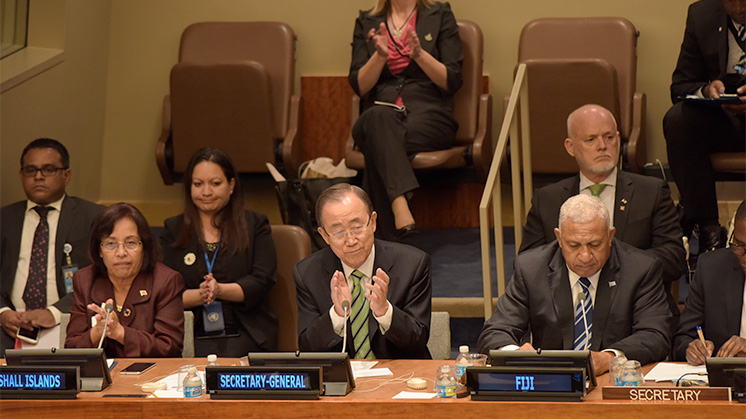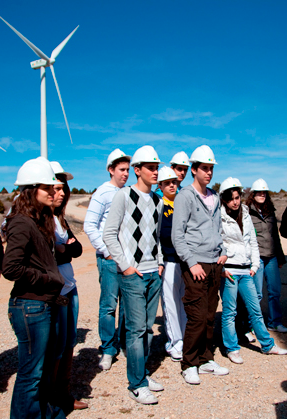Paris Agreement 2015 and COP21
Key points of the Paris Agreement
The Conference of the Parties to the United Nations Framework Convention on Climate Change (COP21) held in 2015 in Paris marked a historic milestone with the adoption of the Paris Agreement. For the first time, both developed and developing countries committed to reducing greenhouse gas emissions to combat climate change. Find out what this agreement is about, what are its key points, which countries are part of it and how it contributes to the energy transition.

The fight against climate change is one of the greatest challenges facing humanity due to its environmental impact and serious consequences for society and the global economy. This is why, over a decade ago, this fight managed to bring almost everyone together to come to an agreement on climate issues. Representatives of nearly 200 countries, meeting at COP21 in Paris in 2015, adopted the first global agreement to curb global warming caused by mankind's greenhouse gas (GHG) emissions: the Paris Agreement. France played a leading role in this meeting by bringing positions closer together and facilitating a consensus within the United Nations and the European Union, which plays a key role in the climate negotiations.
This agreement, which entered into force on 4 November 2016, represents a milestone for its universal nature and significant commitments and targets. Since the inception of the Conferences of the Parties and up to that point, no international agreement had succeeded in committing both developed and developing countries to reduce emissions.
In 2020, the Paris Agreement replaced the Kyoto Protocol, in force until then, as the main international agreement on climate change. The main difference in implementation is that under the Kyoto Protocol all countries had joint emission reduction targets, while the Paris Agreement allowed countries to set their own individual projects and targets. Another major difference is that the Paris Agreement is considered voluntary. However, the submission of pledges is binding, involves all Parties and, for the first time, non-state actors such as regional and local governments, businesses and civil society in general.
The eight key points of the Paris Agreement
The Paris Agreement, adopted by decision 1/CP.21 External link, opens in new window. , covers crucial areas needed to combat climate change. Here are some of the key points of the Paris Agreement
External link, opens in new window. , covers crucial areas needed to combat climate change. Here are some of the key points of the Paris Agreement External link, opens in new window. :
External link, opens in new window. :
 Key point 1: the 2°C target
Key point 1: the 2°C target
The agreement sets the ambitious goal of keeping global warming "well below" 2° C and redoubling efforts to limit the temperature increase to 1.5° C above pre-industrial levels.
 Key point 2: Global emission peaking and climate neutrality
Key point 2: Global emission peaking and climate neutrality
To achieve this temperature goal, Parties set out to reach the global peaking of GHG emissions as soon as possible —taking into account that developing countries would take longer to reach it—. From 2050 onwards, countries should have net zero emissions as soon as possible.
 Key point 3: mitigation
Key point 3: mitigation
Developed countries should continue taking the lead by undertaking economy-wide absolute emission reduction targets, while developing countries should continue promoting mitigation. In addition, the agreement allows the use of markets for countries to collaborate with each other through "International Transfer Mitigation Outcomes" (ITMOs). An example of such a case would be a collaborative agreement between two countries for the purchase and sale of mitigation units.
 Key point 4: sinks and reservoirs
Key point 4: sinks and reservoirs
The Paris Agreement also encourages Parties to conserve and enhance GHG sinks and reservoirs, such as forests, to offset the potential emissions they produce.
 Key point 5: need for adaptation and loss and damage reduction
Key point 5: need for adaptation and loss and damage reduction
The agreement recognises that adaptation is a global challenge and requires countries to implement national adaptation planning processes and pathways for strengthening resilience and minimising vulnerability to climate change. It also highlights the need to avoid, minimise and address loss and damage related to the adverse effects of climate change —for instance, those resulting from extreme weather events—.
 Key point 6: climate finance and technology transfer
Key point 6: climate finance and technology transfer
Under the agreement, developed countries have an obligation to financially support developing countries' efforts to build a clean and climate-resilient future. For the first time, other Parties are also encouraged to provide or continue to provide such support voluntarily. In addition, the need for international cooperation on climate technology development and transfer is reaffirmed.
 Key point 7: promoting education
Key point 7: promoting education
The pact calls for the importance of strengthening education, training and awareness-raising on environmental sustainability, as well as public participation and access to information on climate change.
 Key point 8: boosting transparency
Key point 8: boosting transparency
The Paris Agreement is underpinned by a robust transparency and accounting system to provide clarity on Parties' actions and support. In addition to reporting on mitigation, adaptation and support, the agreement requires that the information submitted by each Party be subject to international technical expert analysis.
Paris Agreement
Key dates
- 2015 Adoption of the Paris Agreement on 12 December.
- 2016 Signature of the Paris Agreement in New York. The European Union deposited the instruments of ratification for the Agreement. The Paris Agreement entered into force on 4 November.
- 2018 Start of negotiations to agree on the operational details for the implementation of the Paris Agreement.
- 2020 New presentation of National Contributions.
- 2021 End of negotiations on the implementation of the Paris Agreement.
- 2023 First full global stocktake.
- 2025 New presentation of National Contributions.
- 2028 Second global stocktake.

 SEE INFOGRAPHIC: Paris Agreement [PDF]
SEE INFOGRAPHIC: Paris Agreement [PDF]
Countries party to the agreement
At the time the Paris Agreement entered into force in 2016, it was ratified by 55 countries representing at least 55% of global emissions. Since then, more countries have continued to ratify. In 2024, the Paris Agreement is already supported by 195 countries.
The Paris Agreement requires all Parties to undertake all possible mechanisms through Nationally Determined Contributions (NDCs) and to progressively redouble their efforts to curb climate change. This implies that all Parties that have ratified the agreement must report regularly on their emissions and environmental contributions. In addition, the agreement provides for a global stocktake every five years to assess collective progress towards the targets set and to report on further action taken by Parties.
The Paris Agreement and its contribution to decarbonising the economy
Since the signing of the Paris Agreement, there has been significant progress in implementing its provisions. Countries have submitted their NDCs, i.e. their detailed plans on how each country will reduce their emissions and adapt to the impacts of climate change. In addition, funds to support developing countries in implementing climate action have been mobilised, such as the Green Climate Fund, established under the Paris Agreement.
However, the progress of this agreement is insufficient in terms of deadlines and objectives set, as the United Nations Secretary General António Guterres recalled on several occasions – insisting on the need to reinforce ambition, determination and speed in taking action.
One of the main challenges is precisely the lack of ambition in the NDCs submitted by countries. According to various analyses, current contributions are not sufficient to limit global warming, and global warming is even increasing. In fact, according to a study led by researchers at Imperial College London External link, opens in new window. , published in the journal Nature Climate Change, if carbon dioxide emissions are not rapidly reduced, the world has a 50 % chance of reaching 1.5° C of warming by 2030.
External link, opens in new window. , published in the journal Nature Climate Change, if carbon dioxide emissions are not rapidly reduced, the world has a 50 % chance of reaching 1.5° C of warming by 2030.
Another major challenge is the large gap between the financial resources needed to implement climate action in developing countries and those available. In addition, the international political context posed significant constraints, such as the withdrawal of the United States from the Paris Agreement in 2020 under the Donald Trump administration, considered a worrying development as one of the world's largest emitters of greenhouse gases. With the subsequent Biden administration, the United States rejoined the agreement, but the possibility of withdrawal by countries with significant emissions concerns the international community.

Origin of the COP
Why are there different COPs and what is their history?

International agreements
Searching for consensus on the fight against climate change.

Climate awareness
Raising social awareness on climate change.

Day against Climate Change
Aware of climate change.
For the energy transition
In the current climate crisis, the drive for energy transition has become the necessary solution to achieve the climate and energy security objectives established in the different international climate agreements, policies and alliances. The aim of this process is to transform the current energy system based primarily on fossil fuels into an electricity model based on renewable energies and other forms of reducing emissions.
At Iberdrola, we are committed to leading this transition, a challenge that we undertook over two decades ago when we placed the fight against climate change at the core of our strategy. Our ambitious climate goals —together with the significant investments made and planned to achieve them, as well as our active involvement in forums, alliances, and international environmental advocacy organisations— allowed us to prioritise the transition towards climate neutrality in all areas of our activity. We are aware that we are in a decisive decade to meet the objectives of the Paris Agreement and that the commitment to a decarbonised society is everyone’s task.




